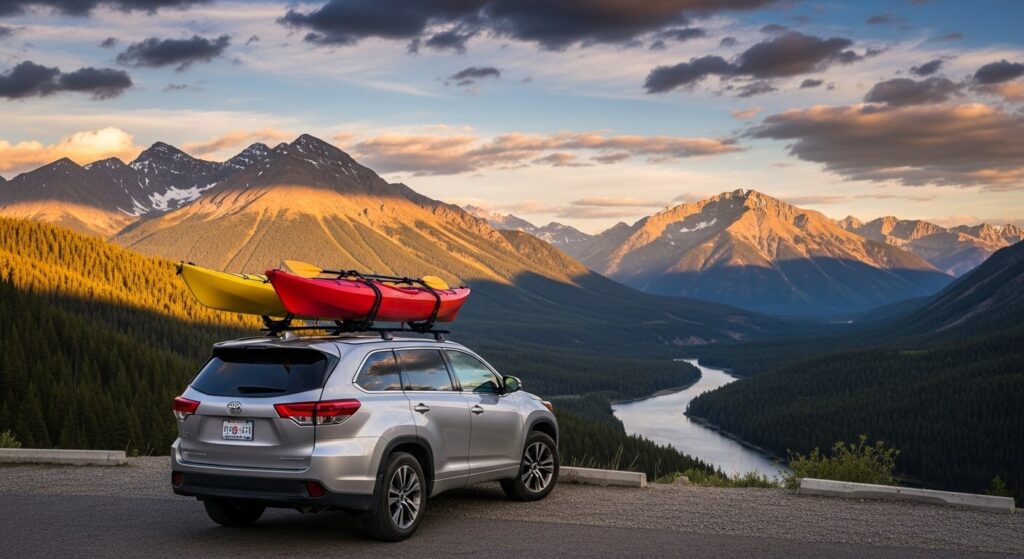If you’ve ever tried strapping a kayak to a Toyota Kluger, you already know the mix of stress and second-guessing that comes with it—ropes slipping, wind noise humming, and that constant worry about whether the boat’s going to shift on the highway. A proper kayak rack changes the whole experience, giving you stability, safety, and peace of mind for both short and long trips. After looking through tons of options, testing for fit, ease of use, and real durability, the one that clearly stands out as the best is the Thule Hullavator Pro. It’s built tough, designed for convenience, and makes loading and unloading way less of a hassle, which is exactly what you want when pairing it with a Kluger.
Best 5 Kayak Rack for Toyota Kluger
01. 7BLACKSMITH J-Bar Roof Rack Kayak Carrier
The 7BLACKSMITH J-Bar Roof Rack Kayak Carrier is built for those who need a solid option for carrying kayaks, canoes, or even surfboards on SUVs, trucks, and cars with crossbars. Its steel construction and padded design give better grip while preventing scratches on your kayak hull. This roof rack fits most round, square, and factory crossbars, making it a versatile fit for outdoor trips and water sports gear hauling. The J-style design also saves roof space, leaving room for other cargo.
Pros ✅
- ✅ Strong steel frame with padded arms for kayak protection
- ✅ Fits most crossbars: round, square, and factory styles
- ✅ Compact J-style rack allows more roof space for extra gear
- ✅ Easy installation with included hardware
Cons ❌
- ❌ Straps provided may feel lighter compared to premium tie-downs
- ❌ Best suited for small to medium-sized kayaks, heavy boats may be harder to load
02. Thule Hull-a-Port Aero Rooftop Kayak Rack
The Thule Hull-a-Port Aero Rooftop Kayak Rack is designed for paddlers who want a solid, secure, and space-saving option for carrying their kayaks. Built with durable aluminum and an aerodynamic profile, this roof-mounted kayak carrier works well with crossbars from brands like Thule, Yakima, and Rhino-Rack. Its folding J-cradle style lets you haul one kayak in an upright position or adjust it to a saddle-style for multiple boats, making it useful for everything from weekend lake trips to coastal kayaking runs. The integrated strap management system also keeps loose ends tucked in while driving.
Pros ✅
- ✅ Aerodynamic shape reduces wind drag and noise
- ✅ Dual position (J-cradle & saddle) design for flexible kayak transport
- ✅ Universal mounting system fits most roof crossbars
- ✅ High weight capacity (up to 130 lbs) for larger kayaks
- ✅ Folds down when not in use for garage clearance
Cons ❌
- ❌ Higher price compared to other rooftop kayak carriers
- ❌ May require two people to load heavier kayaks
- ❌ Limited clearance on some low-roof vehicles
03. Malone Downloader Folding J-Style Universal Kayak Rack
The Malone Downloader Folding J-Style Universal Kayak Rack is a solid option if you’re looking to transport kayaks securely on SUVs, trucks, or crossbars. Built with marine-grade aluminum, this folding J-cradle rack is designed to handle rough conditions while staying lightweight for easy installation. The rack is compatible with most factory and aftermarket roof crossbars, making it versatile for vehicles like Toyota 4Runner, Subaru Outback, Honda CR-V, or Ford Explorer. Its fold-down feature helps reduce wind resistance and lets you pull into garages without hassle.
Pros ✅
- ✅ Strong aluminum construction resists rust and corrosion
- ✅ Fold-down J-cradle saves space and improves garage clearance
- ✅ Compatible with a wide range of crossbars and vehicles
- ✅ Includes cam-style load straps and bow/stern safety tie-downs
Cons ❌
- ❌ Padding may wear down over time with heavy use
- ❌ Requires lifting the kayak higher compared to saddle-style carriers
- ❌ Folding mechanism may loosen if not checked regularly
04. Reese Explore 1394900 J-Rac Kayak Carrier
The Reese Explore 1394900 J-Rac Kayak Carrier is built for paddlers who need a strong and dependable roof rack system for transporting their kayak on SUVs, crossbars, or trucks. Its J-style design allows you to load a kayak at an angle, freeing up roof space for extra gear like a bike rack, cargo box, or another watercraft. The padded cradles help protect the hull, while the sturdy steel frame makes sure your kayak stays put during highway driving or bumpy backroads. It’s a solid choice for outdoor enthusiasts who use vehicles like the Ford F150, Toyota 4Runner, or Subaru Outback and want secure kayak transport without taking up the whole roof.
Pros:
- ✅ Fits most factory and aftermarket crossbars (round, square, and aero).
- ✅ Foam padding protects kayak hulls from scratches.
- ✅ Angled J-cradle saves roof space for other carriers.
- ✅ Durable steel construction for long-lasting use.
Cons:
- ❌ Loading heavier kayaks may require two people.
- ❌ Straps included are basic—upgrading to stronger tie-downs is better.
- ❌ Can add height clearance issues in garages or low bridges.
05. Malone Foldaway-5™ Multi-Rack
The Malone Foldaway-5™ Multi-Rack is a folding kayak and SUP carrier built for people who need a versatile setup that works with canoes, surfboards, or stand-up paddleboards. Its folding J-cradle design lets you carry different watercraft without having to buy multiple racks, making it a solid pick for SUVs, trucks, and crossovers. The steel frame with corrosion-resistant coating means it holds up against road salt and wet conditions, while the foam padding gives protection to kayak hulls and paddleboards during long drives. This rack works with most aftermarket crossbars like Thule, Yakima, and factory-installed roof racks, giving you flexibility no matter what vehicle you’re using.
Pros ✅
- ✅ Works with multiple watercraft: kayaks, canoes, and SUPs
- ✅ Folding design saves roof space and reduces wind drag
- ✅ Fits most aftermarket and OEM crossbars
- ✅ Corrosion-resistant steel frame with protective padding
Cons ❌
- ❌ Installation can be tricky the first time
- ❌ Folding mechanism may loosen if not checked regularly
- ❌ Adds height clearance issues in garages when loaded
How to Choose The Best Kayak Racks for Toyota Kluger
So, you’ve got a Toyota Kluger parked out front and the itch for a kayak trip just won’t go away. That’s me too, staring at the car and the kayak and wondering why life insists on playing Tetris with objects that never quite fit together. Choosing a kayak rack, you’d think, would be like buying a toaster—just pick one, plug it in, done. But nope. The rabbit hole is deep, and you’ll start muttering words like “crossbar spread” and “dynamic load limit” at 2 AM.
The Kluger roof isn’t a blank canvas
The Toyota Kluger (or Highlander if you’re on the other side of the Pacific) is not some flat-roofed van. It’s got rails, sometimes factory-fitted, sometimes missing, depending on the trim. And here’s the kicker: the load rating on the roof? Around 75 kg (varies slightly depending on year, but roughly in that zone). That means if your kayak is 25 kg and your rack system weighs another 15 kg, you start running out of allowance real quick. Toss a second kayak on there and suddenly you’re over the safe rating. I once saw a guy’s roof bow down slightly like it was sighing under the weight—never again.
Crossbars: the bones of the whole thing
Here’s where people mess up: they grab any cheap crossbar kit because it “fits” the Kluger. But fit doesn’t always mean safe. The crossbar spread on a Kluger is shorter than, say, a LandCruiser. A short spread means less stability. Imagine balancing a broom on two fingers versus on your whole hand. That’s the difference.
Brands like Thule and Rhino-Rack usually dominate the conversation. They’re pricey, sure, but they’ve tested their gear against Australian regulations and even icy Scandinavian winds. Some cheaper brands… well, let’s just say if the clamps creak after the first storm, don’t be shocked.
Styles of kayak racks that actually make sense
Here’s where your decision forks.
- J-cradles: Those upright, angled carriers. Good if you want to carry two kayaks side by side because they tilt them up. But they do catch more wind. I had mine whistle on the freeway like a kazoo until I adjusted the angle.
- Saddles: The kayak lays flat on the roof. Stable, less wind noise, but eats up the entire crossbar real estate. If it’s just one kayak, this is the comfiest option.
- Stackers: More common on whitewater paddlers’ cars. They let you pile kayaks like you’re stacking pancakes. On a Kluger, though, with its roof height? You’ll need a step stool or some gymnastic moves.
Getting it on and off without a wrestling match
Here’s a truth that doesn’t get said enough: lifting a 25 kg kayak onto a Kluger roof after paddling all day feels like hoisting a wet mattress above your head. You’re tired, sunburnt, and probably hangry. That’s why some people cough up the cash for lift-assist racks. Thule has the Hullavator, which is basically a spring-loaded arm that lowers the kayak down to waist height. Genius. Expensive, like “maybe I should’ve just bought a secondhand trailer” expensive. But if you paddle twice a week, it’s a back-saver.
Wind, fuel, and the unspoken costs
You strap a kayak on top and suddenly your Kluger feels like it’s dragging a parachute. Fuel economy? Down by 10–15% according to some owners who track their numbers. Noise? Yes, you’ll hear it. A long, hollow whoosh that you swear is going to drive you mad on a 4-hour drive to the coast. Adding a wind fairing helps, but again, that’s more gear, more cash.
Some stats to ground all this rambling
- Average recreational kayak weight: 20–30 kg
- Toyota Kluger roof load rating: ~75 kg
- Common J-cradle weight: 6–10 kg each
- Hullavator lift assist rack: ~18 kg per side
Put those numbers together and you see how quickly the math piles up. Two kayaks, two J-cradles, plus bars… you’re nudging the limit before you even tie the bow line.
Random things nobody tells you until too late
- Foam blocks are cheap but will rub paint off your roof rails like sandpaper if you’re not careful.
- Ratchet straps are overkill; cam buckle straps are kinder to your kayak and your nerves.
- If you park in a garage, measure the clearance first. I’ve watched a friend slowly peel his kayak off on a low concrete beam like it was a banana skin.
So what’s the “best” setup then?
There isn’t one neat answer. If it’s one kayak and you value sanity: flat saddles. If it’s two kayaks and you’re okay with some wind noise: J-cradles. If you paddle every weekend and your shoulders aren’t what they used to be: save up for lift assist.
It’s less about the rack itself and more about how often you’ll actually use it. The wrong setup makes kayaking feel like a chore before you even hit the water. And that, frankly, is the fastest way to let your kayak gather cobwebs in the garage.






